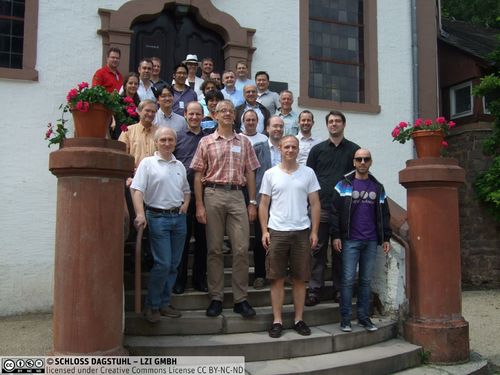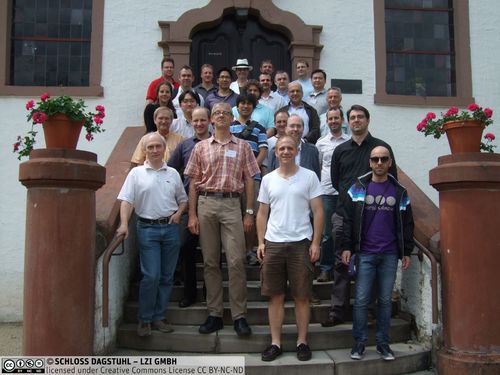Dagstuhl-Seminar 12272
Architecture-Driven Semantic Analysis of Embedded Systems
( 01. Jul – 06. Jul, 2012 )
Permalink
Organisatoren
- Peter H. Feiler (Carnegie Mellon University - Pittsburgh, US)
- Jérôme Hugues (ISAE - Toulouse, FR)
- Oleg Sokolsky (University of Pennsylvania - Philadelphia, US)
Kontakt
- Susanne Bach-Bernhard (für administrative Fragen)
Architectural modeling of complex embedded systems is gaining prominence in recent years, both in academia and in industry. An architectural model represents components in a distributed system as boxes with well-defined interfaces, connections between ports on component interfaces, and specifies component properties that can be used in analytical reasoning about the model. Models are hierarchically organized, so that each box can contain another system inside, with its own set of boxes and connections between them. An architecture description language for embedded systems, for which timing and resource availability form an important part of the requirements, must describe resources of the system platform, such as processors, memories, communication links, etc. Several architectural modeling languages for embedded systems have emerged in recent years, including AADL, SysML, EAST-ADL, and the MARTE profile for UML.
In the context of model-based engineering (MBE) architectural modeling serves several important purposes:
An architectural model allows us to break the system into manageable parts and establish clear interfaces between these parts. In this way, we can manage complexity of the system by hiding the details that are unimportant at a given level of consideration; Clear interfaces between the components allow us to avoid integration problems at the implementation phase. Connections between components, which specify how components affect each other, help propagate the effects of change in one component to the affected components. Most importantly, an architectural model can be seen as a repository of the knowledge about the system, represented as requirements, design, and implementation artifacts, held together by the architecture. Such a repository enables automatic generation of analytical models for different aspects of the system, such as timing, reliability, security, performance, etc. Since all the models are generated from the same source, ensuring consistency of assumptions and abstractions used in different analyses becomes easier. The first two uses of architectural modeling have been studied in the research literature for a number of years. However, the coordination role of architectural modeling in MBE is just currently emerging. We expect this role to gain importance in the coming years. It is clear that realizing this vision of "single-source" MBE with an architectural model at its core is impossible without having first a clear semantics of the architecture description language.
The goal of the seminar is to bring together researchers who are interested in defining precise semantics of an architecture description language and using it for building tools that generate analytical models from architectural ones, as well as generate code and configuration scripts for the system. Despite recent research activity in this area to use semantic interpretation of architectural models for analytical model generation, we observe a significant gap between current state of the art and the practical need to handle complex models. In practice, most approaches cover a limited subset of the language and target a small number of modeling patterns. A more general approach would most likely require an interpretation of the semantics of the language by the tool, instead of hard-coding of the semantics and patterns into the model generator.
- De-Jiu Chen (KTH Royal Institute of Technology, SE)
- Silvano Dal Zilio (LAAS - Toulouse, FR) [dblp]
- Patricia Derler (University of California - Berkeley, US) [dblp]
- Mamoun Filali-Amine (Paul Sabatier University - Toulouse, FR)
- Laurent Fournier (Rockwell Collins France - Toulouse, FR)
- Serban Gheorghe (Edgewater Computer Systems Inc. - Ottawa, CA)
- Lars Grunske (TU Kaiserslautern, DE) [dblp]
- Jérôme Hugues (ISAE - Toulouse, FR) [dblp]
- Naoki Ishihama (JAXA - Ibaraki, JP)
- Gabor Karsai (Vanderbilt University, US) [dblp]
- Alexey Khoroshilov (Russian Academy of Sciences - Moscow, RU) [dblp]
- Fabrice Kordon (UPMC - Paris, FR) [dblp]
- Brian Larson (Multitude Corp., US) [dblp]
- Bruce Lewis (US Army AMRDEC, US)
- Ivano Malavolta (University of L'Aquila, IT) [dblp]
- Frédéric Mallet (INRIA Sophia Antipolis - Méditerranée, FR) [dblp]
- Pieter J. Mosterman (The MathWorks Inc. - Natick, US) [dblp]
- Viet Yen Nguyen (RWTH Aachen, DE)
- Thomas Noll (RWTH Aachen, DE) [dblp]
- Peter Csaba Ölveczky (University of Illinois - Urbana-Champaign, US) [dblp]
- Paul Pettersson (Mälardalen University - Västerås, SE)
- Ramon Serna Oliver (TTTech Computertechnik - Wien, AT)
- Shin'ichi Shiraishi (TOYOTA InfoTechnology Center USA Inc., US) [dblp]
- Frank Singhoff (University of Brest, FR)
- Oleg Sokolsky (University of Pennsylvania - Philadelphia, US) [dblp]
- Jean-Pierre Talpin (INRIA Rennes - Bretagne Atlantique, FR)
- Michael W. Whalen (University of Minnesota - Minneapolis, US) [dblp]
Klassifikation
- modelling / simulation
- semantics / formal methods
- software engineering
Schlagworte
- architectural modeling
- virtual integration
- model-based engineering
- modeling semantics



